Analyzing Leadership & Management Roles in H&M Operations Strategy
VerifiedAdded on 2024/06/10
|22
|4601
|202
Report
AI Summary
This report provides an in-depth analysis of leadership and management within business operations, specifically focusing on the H&M company. It defines and compares the roles and characteristics of leaders and managers, highlighting their importance in organizational success. The report explores the application of leadership roles and management functions in various organizational situations, using examples from H&M to illustrate key concepts. Furthermore, it examines the application of different leadership theories and models, such as situational leadership and contingency leadership, to enhance organizational effectiveness and profitability. The analysis emphasizes the importance of motivating and influencing employees to achieve common organizational goals. Task 2 briefly touches upon key approaches to operations management and the roles that leaders and managers play in ensuring efficiency and continuous improvement within the organization.
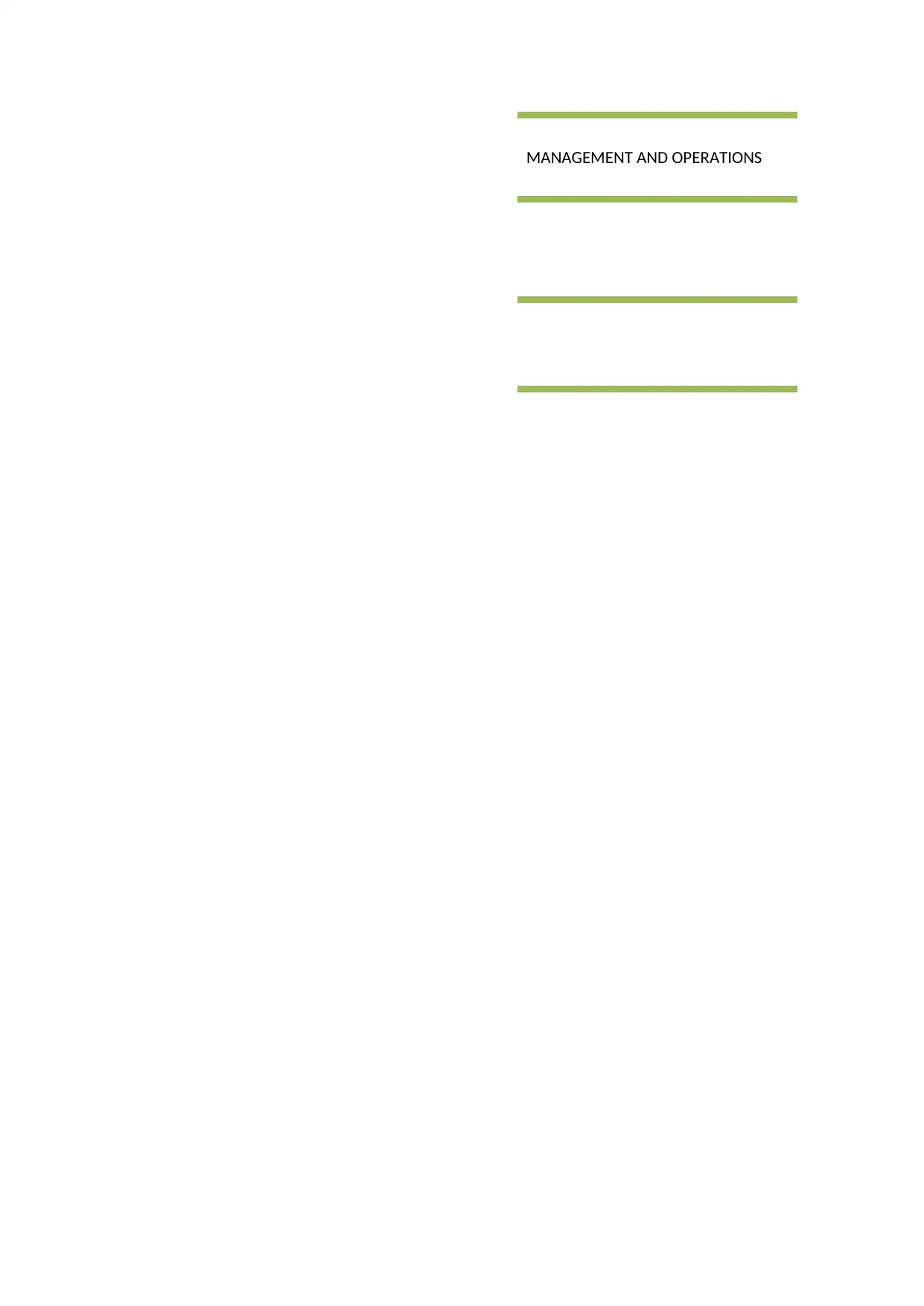
MANAGEMENT AND OPERATIONS
Paraphrase This Document
Need a fresh take? Get an instant paraphrase of this document with our AI Paraphraser
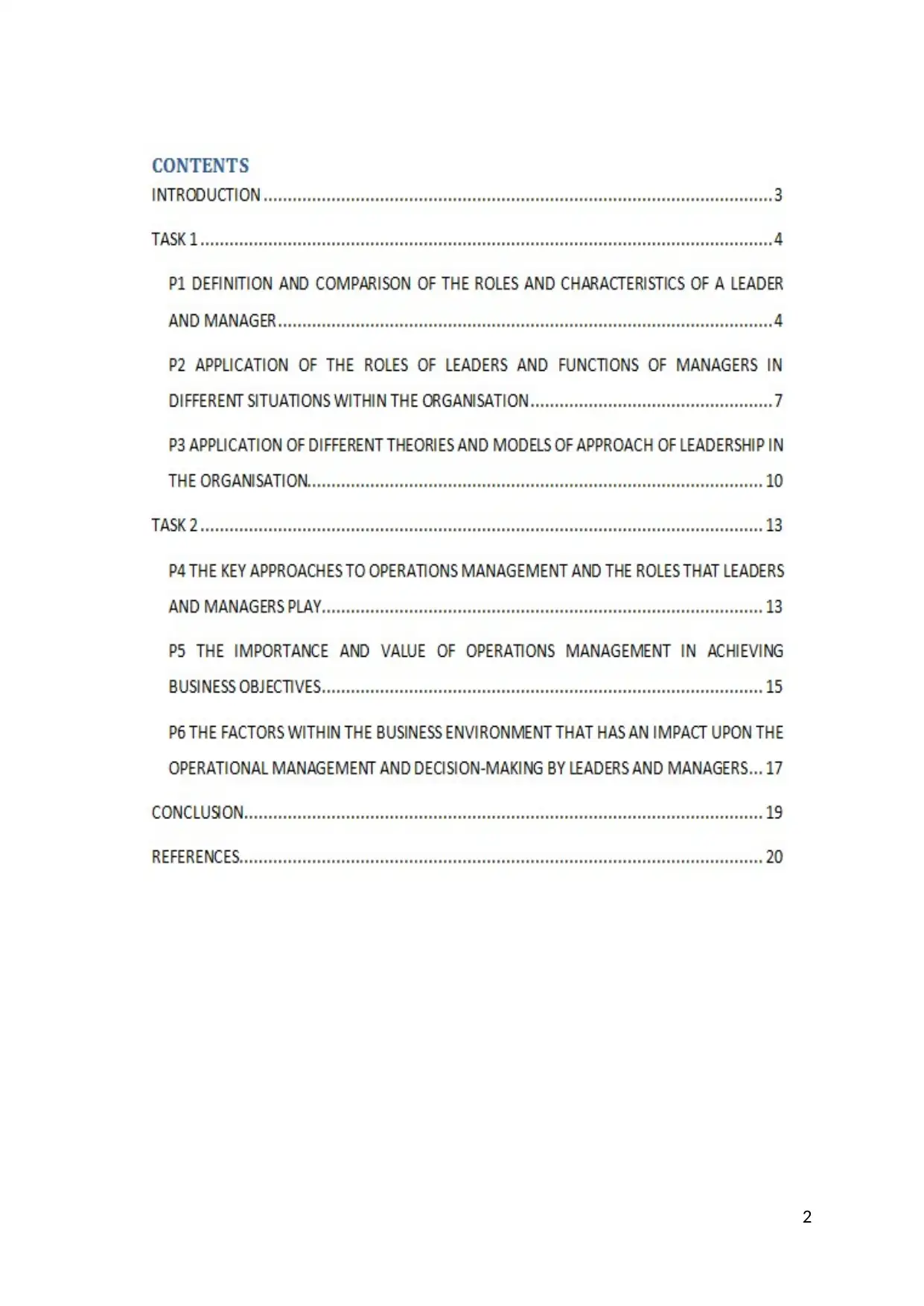
2
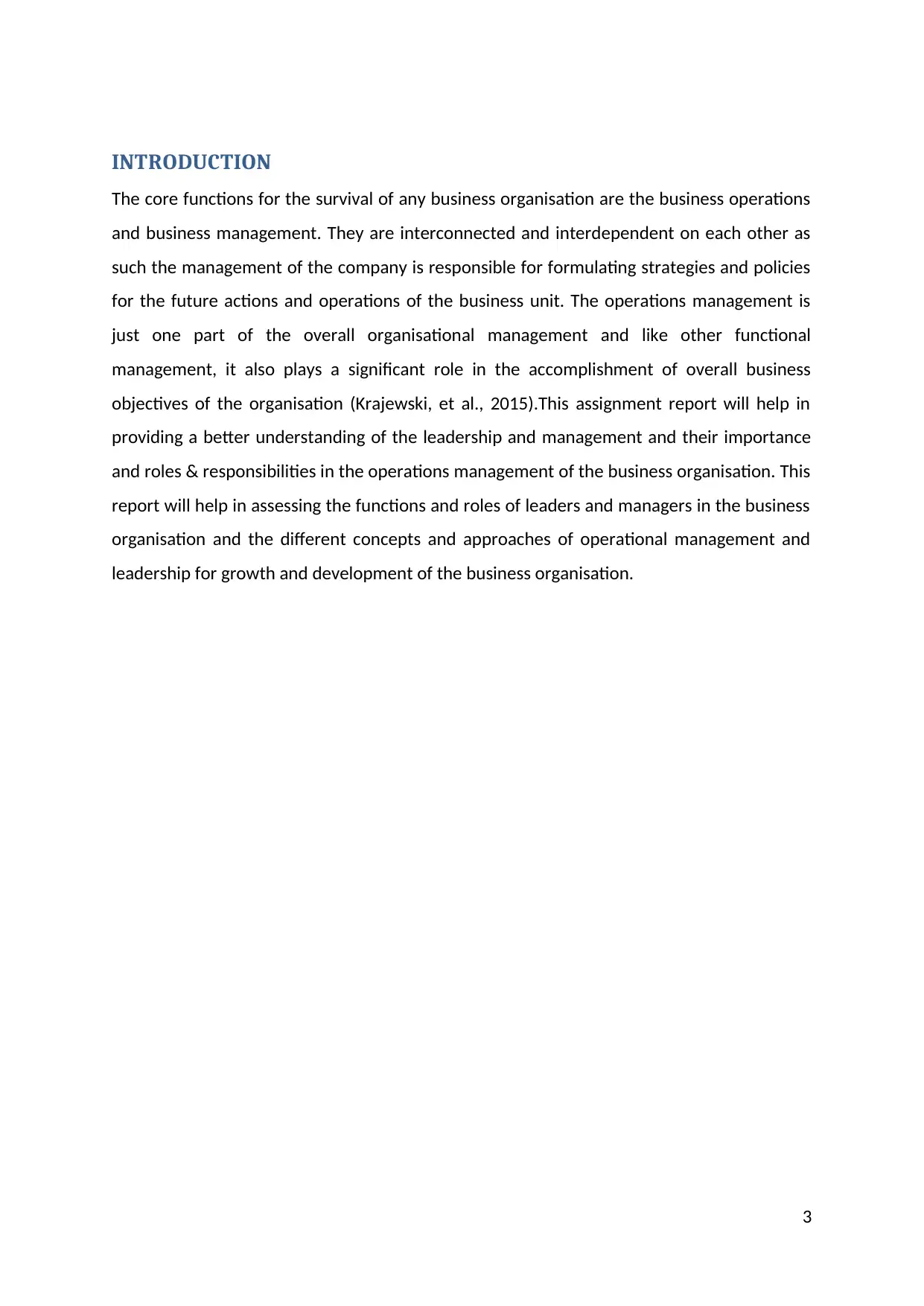
INTRODUCTION
The core functions for the survival of any business organisation are the business operations
and business management. They are interconnected and interdependent on each other as
such the management of the company is responsible for formulating strategies and policies
for the future actions and operations of the business unit. The operations management is
just one part of the overall organisational management and like other functional
management, it also plays a significant role in the accomplishment of overall business
objectives of the organisation (Krajewski, et al., 2015).This assignment report will help in
providing a better understanding of the leadership and management and their importance
and roles & responsibilities in the operations management of the business organisation. This
report will help in assessing the functions and roles of leaders and managers in the business
organisation and the different concepts and approaches of operational management and
leadership for growth and development of the business organisation.
3
The core functions for the survival of any business organisation are the business operations
and business management. They are interconnected and interdependent on each other as
such the management of the company is responsible for formulating strategies and policies
for the future actions and operations of the business unit. The operations management is
just one part of the overall organisational management and like other functional
management, it also plays a significant role in the accomplishment of overall business
objectives of the organisation (Krajewski, et al., 2015).This assignment report will help in
providing a better understanding of the leadership and management and their importance
and roles & responsibilities in the operations management of the business organisation. This
report will help in assessing the functions and roles of leaders and managers in the business
organisation and the different concepts and approaches of operational management and
leadership for growth and development of the business organisation.
3
⊘ This is a preview!⊘
Do you want full access?
Subscribe today to unlock all pages.

Trusted by 1+ million students worldwide
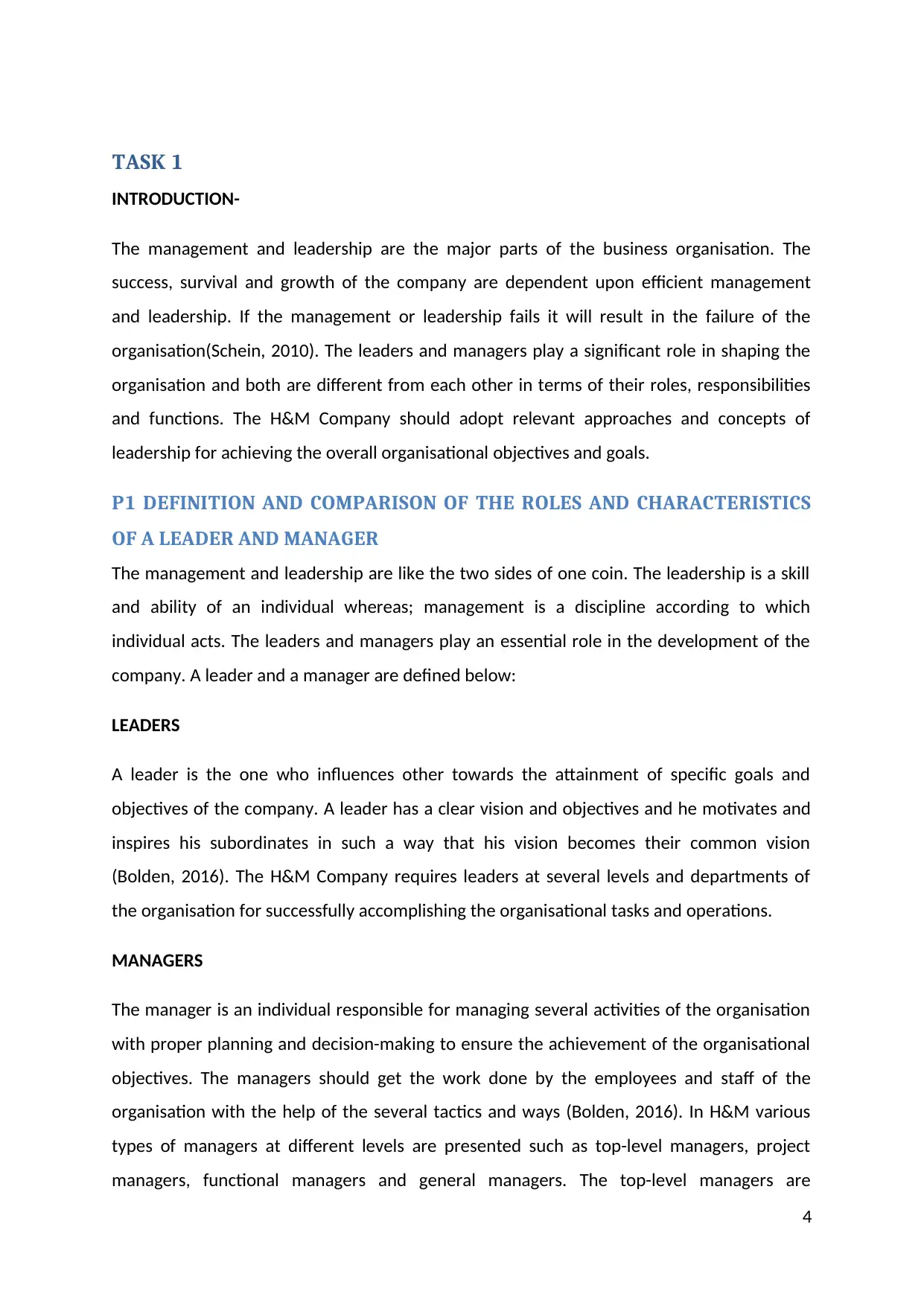
TASK 1
INTRODUCTION-
The management and leadership are the major parts of the business organisation. The
success, survival and growth of the company are dependent upon efficient management
and leadership. If the management or leadership fails it will result in the failure of the
organisation(Schein, 2010). The leaders and managers play a significant role in shaping the
organisation and both are different from each other in terms of their roles, responsibilities
and functions. The H&M Company should adopt relevant approaches and concepts of
leadership for achieving the overall organisational objectives and goals.
P1 DEFINITION AND COMPARISON OF THE ROLES AND CHARACTERISTICS
OF A LEADER AND MANAGER
The management and leadership are like the two sides of one coin. The leadership is a skill
and ability of an individual whereas; management is a discipline according to which
individual acts. The leaders and managers play an essential role in the development of the
company. A leader and a manager are defined below:
LEADERS
A leader is the one who influences other towards the attainment of specific goals and
objectives of the company. A leader has a clear vision and objectives and he motivates and
inspires his subordinates in such a way that his vision becomes their common vision
(Bolden, 2016). The H&M Company requires leaders at several levels and departments of
the organisation for successfully accomplishing the organisational tasks and operations.
MANAGERS
The manager is an individual responsible for managing several activities of the organisation
with proper planning and decision-making to ensure the achievement of the organisational
objectives. The managers should get the work done by the employees and staff of the
organisation with the help of the several tactics and ways (Bolden, 2016). In H&M various
types of managers at different levels are presented such as top-level managers, project
managers, functional managers and general managers. The top-level managers are
4
INTRODUCTION-
The management and leadership are the major parts of the business organisation. The
success, survival and growth of the company are dependent upon efficient management
and leadership. If the management or leadership fails it will result in the failure of the
organisation(Schein, 2010). The leaders and managers play a significant role in shaping the
organisation and both are different from each other in terms of their roles, responsibilities
and functions. The H&M Company should adopt relevant approaches and concepts of
leadership for achieving the overall organisational objectives and goals.
P1 DEFINITION AND COMPARISON OF THE ROLES AND CHARACTERISTICS
OF A LEADER AND MANAGER
The management and leadership are like the two sides of one coin. The leadership is a skill
and ability of an individual whereas; management is a discipline according to which
individual acts. The leaders and managers play an essential role in the development of the
company. A leader and a manager are defined below:
LEADERS
A leader is the one who influences other towards the attainment of specific goals and
objectives of the company. A leader has a clear vision and objectives and he motivates and
inspires his subordinates in such a way that his vision becomes their common vision
(Bolden, 2016). The H&M Company requires leaders at several levels and departments of
the organisation for successfully accomplishing the organisational tasks and operations.
MANAGERS
The manager is an individual responsible for managing several activities of the organisation
with proper planning and decision-making to ensure the achievement of the organisational
objectives. The managers should get the work done by the employees and staff of the
organisation with the help of the several tactics and ways (Bolden, 2016). In H&M various
types of managers at different levels are presented such as top-level managers, project
managers, functional managers and general managers. The top-level managers are
4
Paraphrase This Document
Need a fresh take? Get an instant paraphrase of this document with our AI Paraphraser
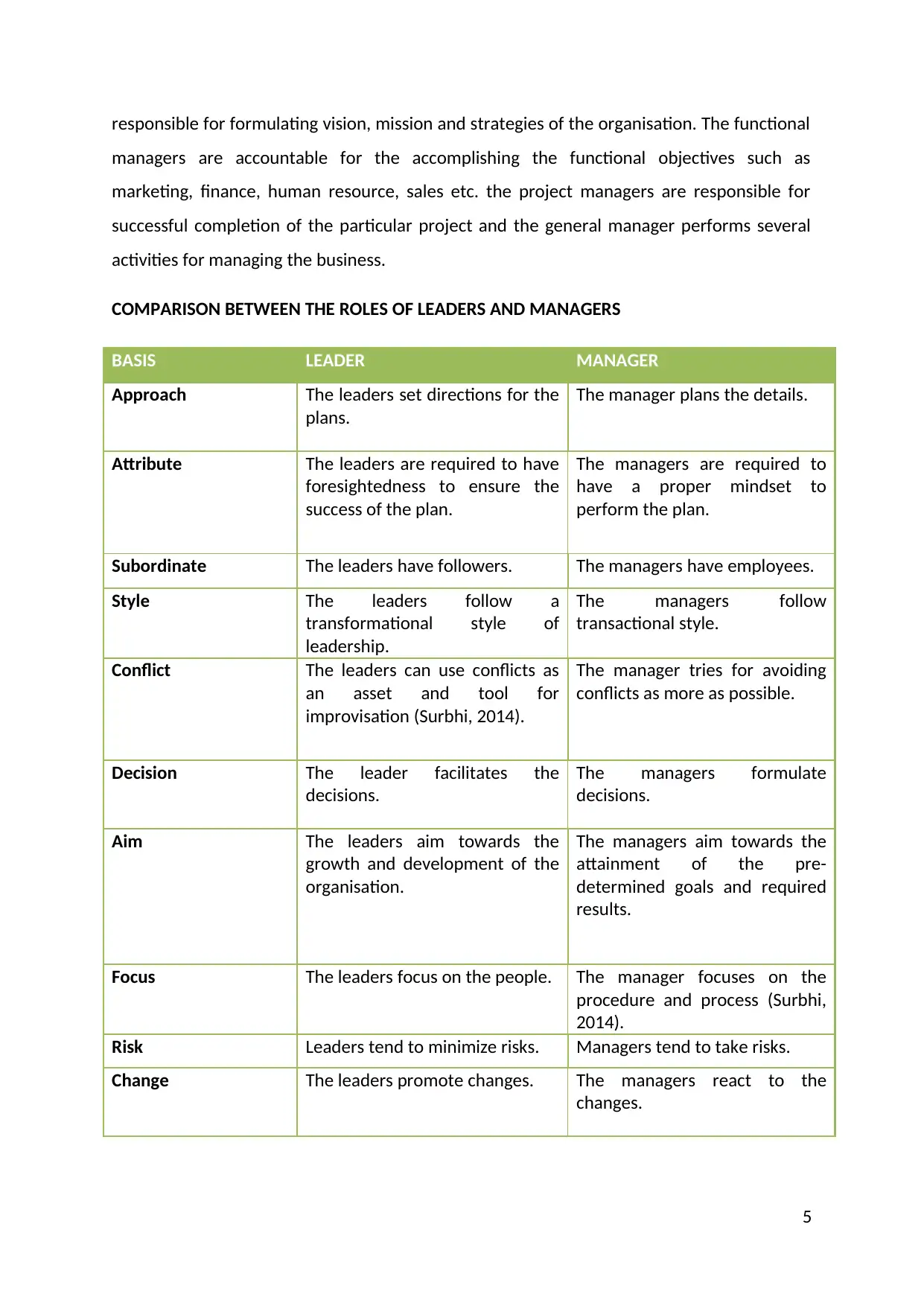
responsible for formulating vision, mission and strategies of the organisation. The functional
managers are accountable for the accomplishing the functional objectives such as
marketing, finance, human resource, sales etc. the project managers are responsible for
successful completion of the particular project and the general manager performs several
activities for managing the business.
COMPARISON BETWEEN THE ROLES OF LEADERS AND MANAGERS
BASIS LEADER MANAGER
Approach The leaders set directions for the
plans.
The manager plans the details.
Attribute The leaders are required to have
foresightedness to ensure the
success of the plan.
The managers are required to
have a proper mindset to
perform the plan.
Subordinate The leaders have followers. The managers have employees.
Style The leaders follow a
transformational style of
leadership.
The managers follow
transactional style.
Conflict The leaders can use conflicts as
an asset and tool for
improvisation (Surbhi, 2014).
The manager tries for avoiding
conflicts as more as possible.
Decision The leader facilitates the
decisions.
The managers formulate
decisions.
Aim The leaders aim towards the
growth and development of the
organisation.
The managers aim towards the
attainment of the pre-
determined goals and required
results.
Focus The leaders focus on the people. The manager focuses on the
procedure and process (Surbhi,
2014).
Risk Leaders tend to minimize risks. Managers tend to take risks.
Change The leaders promote changes. The managers react to the
changes.
5
managers are accountable for the accomplishing the functional objectives such as
marketing, finance, human resource, sales etc. the project managers are responsible for
successful completion of the particular project and the general manager performs several
activities for managing the business.
COMPARISON BETWEEN THE ROLES OF LEADERS AND MANAGERS
BASIS LEADER MANAGER
Approach The leaders set directions for the
plans.
The manager plans the details.
Attribute The leaders are required to have
foresightedness to ensure the
success of the plan.
The managers are required to
have a proper mindset to
perform the plan.
Subordinate The leaders have followers. The managers have employees.
Style The leaders follow a
transformational style of
leadership.
The managers follow
transactional style.
Conflict The leaders can use conflicts as
an asset and tool for
improvisation (Surbhi, 2014).
The manager tries for avoiding
conflicts as more as possible.
Decision The leader facilitates the
decisions.
The managers formulate
decisions.
Aim The leaders aim towards the
growth and development of the
organisation.
The managers aim towards the
attainment of the pre-
determined goals and required
results.
Focus The leaders focus on the people. The manager focuses on the
procedure and process (Surbhi,
2014).
Risk Leaders tend to minimize risks. Managers tend to take risks.
Change The leaders promote changes. The managers react to the
changes.
5
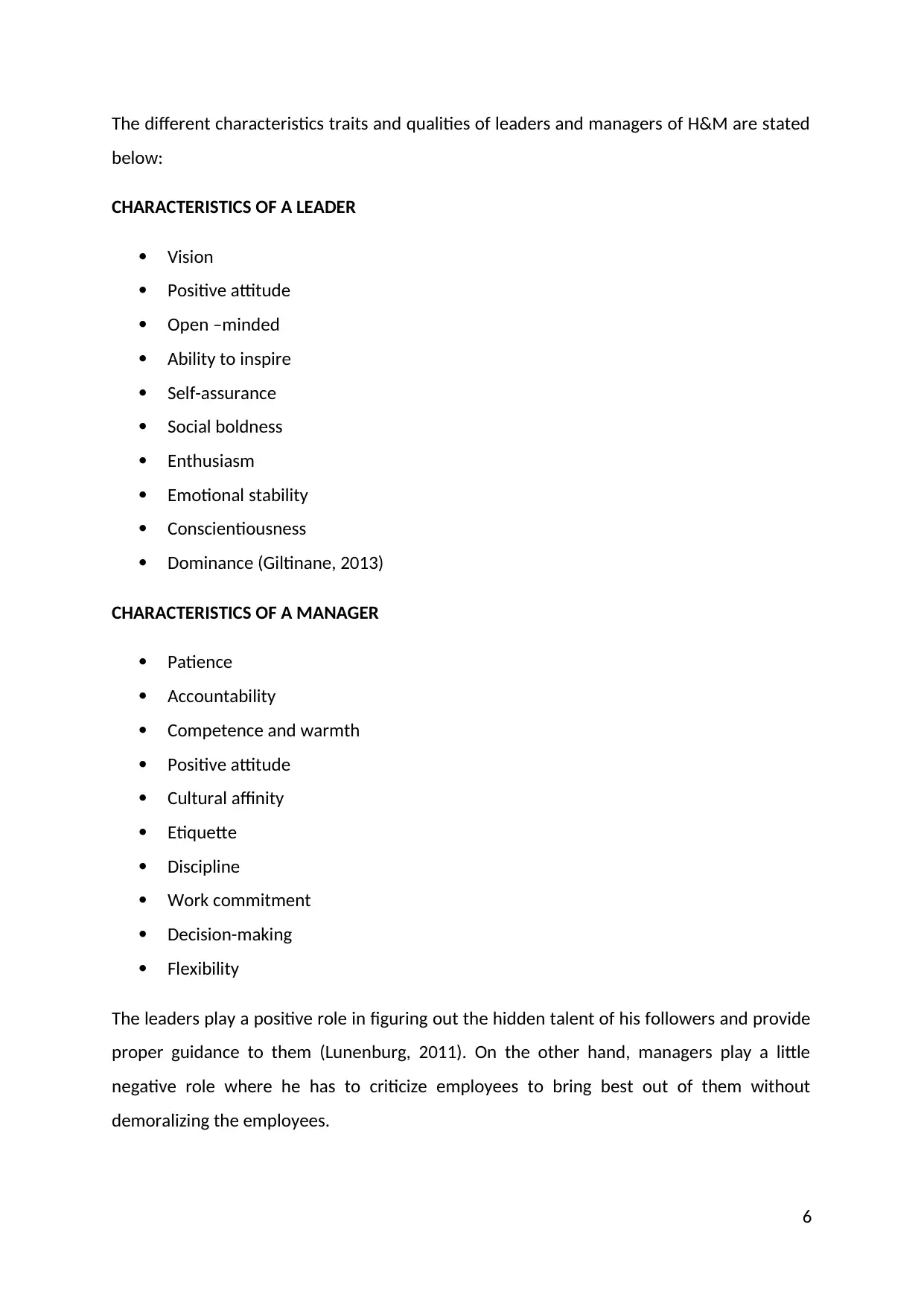
The different characteristics traits and qualities of leaders and managers of H&M are stated
below:
CHARACTERISTICS OF A LEADER
Vision
Positive attitude
Open –minded
Ability to inspire
Self-assurance
Social boldness
Enthusiasm
Emotional stability
Conscientiousness
Dominance (Giltinane, 2013)
CHARACTERISTICS OF A MANAGER
Patience
Accountability
Competence and warmth
Positive attitude
Cultural affinity
Etiquette
Discipline
Work commitment
Decision-making
Flexibility
The leaders play a positive role in figuring out the hidden talent of his followers and provide
proper guidance to them (Lunenburg, 2011). On the other hand, managers play a little
negative role where he has to criticize employees to bring best out of them without
demoralizing the employees.
6
below:
CHARACTERISTICS OF A LEADER
Vision
Positive attitude
Open –minded
Ability to inspire
Self-assurance
Social boldness
Enthusiasm
Emotional stability
Conscientiousness
Dominance (Giltinane, 2013)
CHARACTERISTICS OF A MANAGER
Patience
Accountability
Competence and warmth
Positive attitude
Cultural affinity
Etiquette
Discipline
Work commitment
Decision-making
Flexibility
The leaders play a positive role in figuring out the hidden talent of his followers and provide
proper guidance to them (Lunenburg, 2011). On the other hand, managers play a little
negative role where he has to criticize employees to bring best out of them without
demoralizing the employees.
6
⊘ This is a preview!⊘
Do you want full access?
Subscribe today to unlock all pages.

Trusted by 1+ million students worldwide

P2 APPLICATION OF THE ROLES OF LEADERS AND FUNCTIONS OF
MANAGERS IN DIFFERENT SITUATIONS WITHIN THE ORGANISATION
The roles of leaders and the function of manager shape the overall activities and operations
of the organisation. The roles of leaders and the functions of managers are discussed below:
ROLES OF LEADERS:
Inspire people: the successful leaders are credible for inspiring the followers and
other people with a character and competence.
Create a vision: the main role of leaders is to clearly define where the team or a
group is going and how they can reach there.
Execute the strategy: the leaders are required to continuously and consistently
achieve the results through the process (Lunenburg, 2011).
Potential coaching and guidance: the leaders are required to provide guidance to
the followers and unleash their abilities for improving the performance of the overall
group.
FUNCTIONS OF MANAGERS:
According to Henri Fayol the five major functions of managers are:
Figure 1 Functions of Manager
7
MANAGERS IN DIFFERENT SITUATIONS WITHIN THE ORGANISATION
The roles of leaders and the function of manager shape the overall activities and operations
of the organisation. The roles of leaders and the functions of managers are discussed below:
ROLES OF LEADERS:
Inspire people: the successful leaders are credible for inspiring the followers and
other people with a character and competence.
Create a vision: the main role of leaders is to clearly define where the team or a
group is going and how they can reach there.
Execute the strategy: the leaders are required to continuously and consistently
achieve the results through the process (Lunenburg, 2011).
Potential coaching and guidance: the leaders are required to provide guidance to
the followers and unleash their abilities for improving the performance of the overall
group.
FUNCTIONS OF MANAGERS:
According to Henri Fayol the five major functions of managers are:
Figure 1 Functions of Manager
7
Paraphrase This Document
Need a fresh take? Get an instant paraphrase of this document with our AI Paraphraser
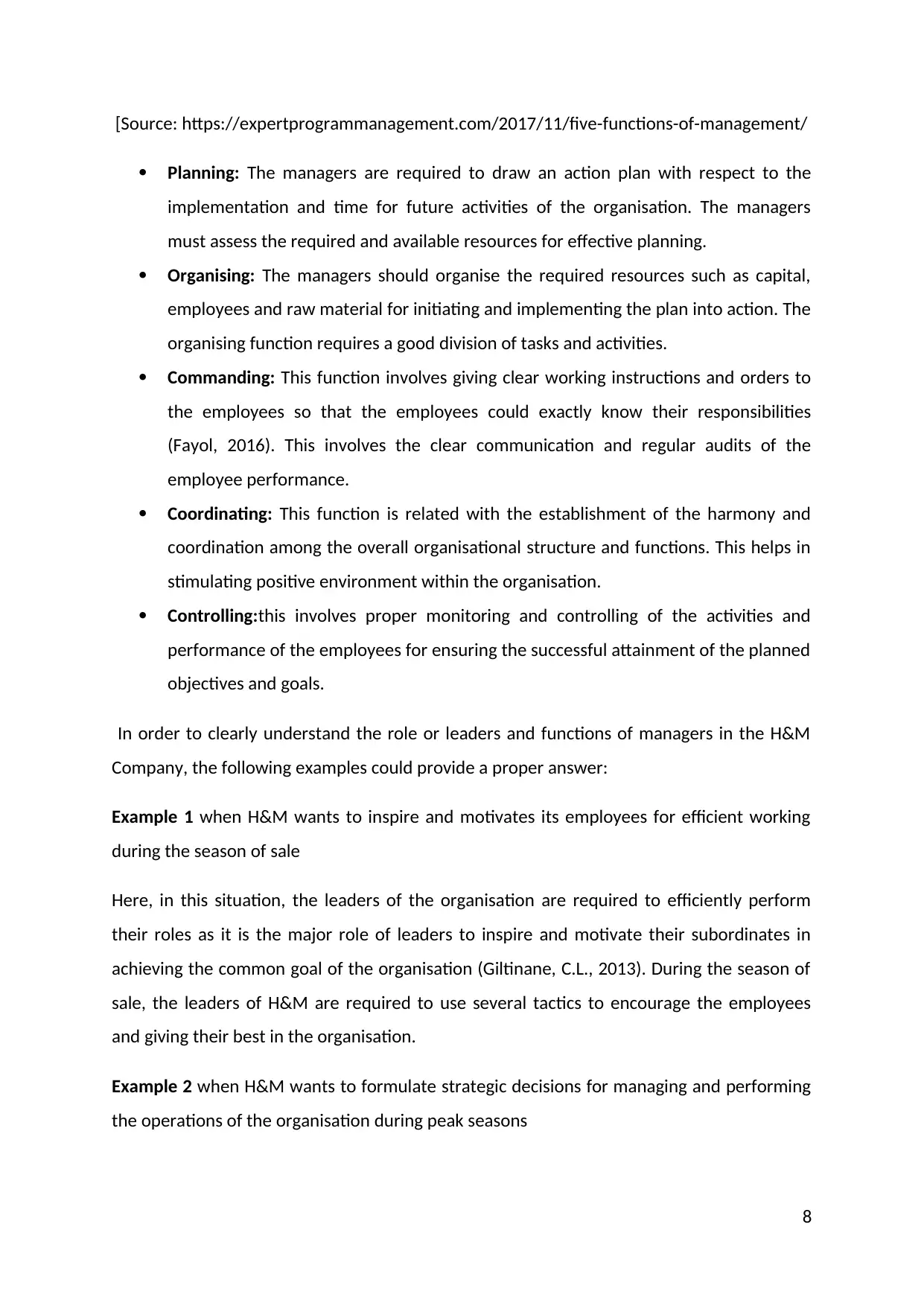
[Source: https://expertprogrammanagement.com/2017/11/five-functions-of-management/
Planning: The managers are required to draw an action plan with respect to the
implementation and time for future activities of the organisation. The managers
must assess the required and available resources for effective planning.
Organising: The managers should organise the required resources such as capital,
employees and raw material for initiating and implementing the plan into action. The
organising function requires a good division of tasks and activities.
Commanding: This function involves giving clear working instructions and orders to
the employees so that the employees could exactly know their responsibilities
(Fayol, 2016). This involves the clear communication and regular audits of the
employee performance.
Coordinating: This function is related with the establishment of the harmony and
coordination among the overall organisational structure and functions. This helps in
stimulating positive environment within the organisation.
Controlling:this involves proper monitoring and controlling of the activities and
performance of the employees for ensuring the successful attainment of the planned
objectives and goals.
In order to clearly understand the role or leaders and functions of managers in the H&M
Company, the following examples could provide a proper answer:
Example 1 when H&M wants to inspire and motivates its employees for efficient working
during the season of sale
Here, in this situation, the leaders of the organisation are required to efficiently perform
their roles as it is the major role of leaders to inspire and motivate their subordinates in
achieving the common goal of the organisation (Giltinane, C.L., 2013). During the season of
sale, the leaders of H&M are required to use several tactics to encourage the employees
and giving their best in the organisation.
Example 2 when H&M wants to formulate strategic decisions for managing and performing
the operations of the organisation during peak seasons
8
Planning: The managers are required to draw an action plan with respect to the
implementation and time for future activities of the organisation. The managers
must assess the required and available resources for effective planning.
Organising: The managers should organise the required resources such as capital,
employees and raw material for initiating and implementing the plan into action. The
organising function requires a good division of tasks and activities.
Commanding: This function involves giving clear working instructions and orders to
the employees so that the employees could exactly know their responsibilities
(Fayol, 2016). This involves the clear communication and regular audits of the
employee performance.
Coordinating: This function is related with the establishment of the harmony and
coordination among the overall organisational structure and functions. This helps in
stimulating positive environment within the organisation.
Controlling:this involves proper monitoring and controlling of the activities and
performance of the employees for ensuring the successful attainment of the planned
objectives and goals.
In order to clearly understand the role or leaders and functions of managers in the H&M
Company, the following examples could provide a proper answer:
Example 1 when H&M wants to inspire and motivates its employees for efficient working
during the season of sale
Here, in this situation, the leaders of the organisation are required to efficiently perform
their roles as it is the major role of leaders to inspire and motivate their subordinates in
achieving the common goal of the organisation (Giltinane, C.L., 2013). During the season of
sale, the leaders of H&M are required to use several tactics to encourage the employees
and giving their best in the organisation.
Example 2 when H&M wants to formulate strategic decisions for managing and performing
the operations of the organisation during peak seasons
8
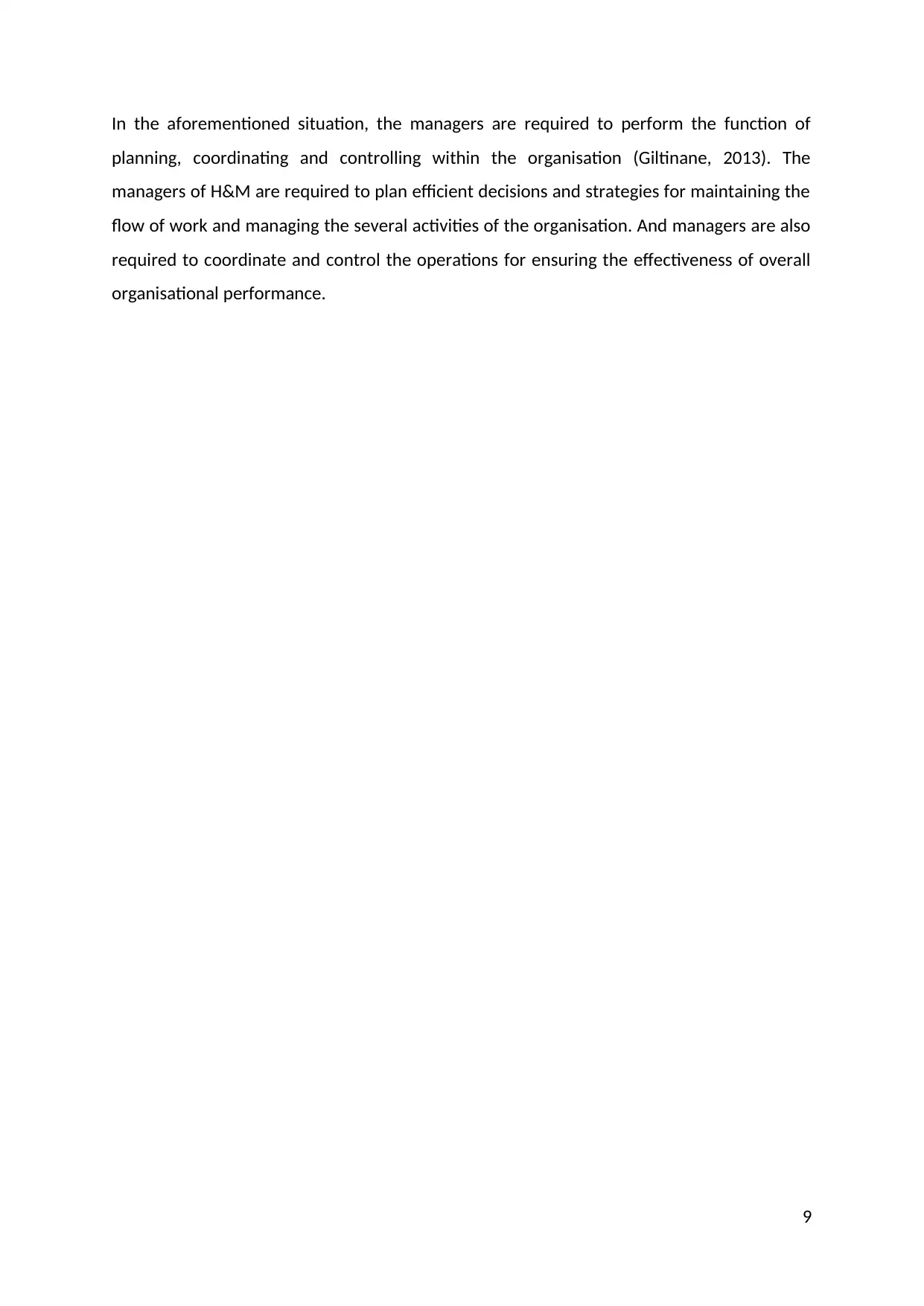
In the aforementioned situation, the managers are required to perform the function of
planning, coordinating and controlling within the organisation (Giltinane, 2013). The
managers of H&M are required to plan efficient decisions and strategies for maintaining the
flow of work and managing the several activities of the organisation. And managers are also
required to coordinate and control the operations for ensuring the effectiveness of overall
organisational performance.
9
planning, coordinating and controlling within the organisation (Giltinane, 2013). The
managers of H&M are required to plan efficient decisions and strategies for maintaining the
flow of work and managing the several activities of the organisation. And managers are also
required to coordinate and control the operations for ensuring the effectiveness of overall
organisational performance.
9
⊘ This is a preview!⊘
Do you want full access?
Subscribe today to unlock all pages.

Trusted by 1+ million students worldwide
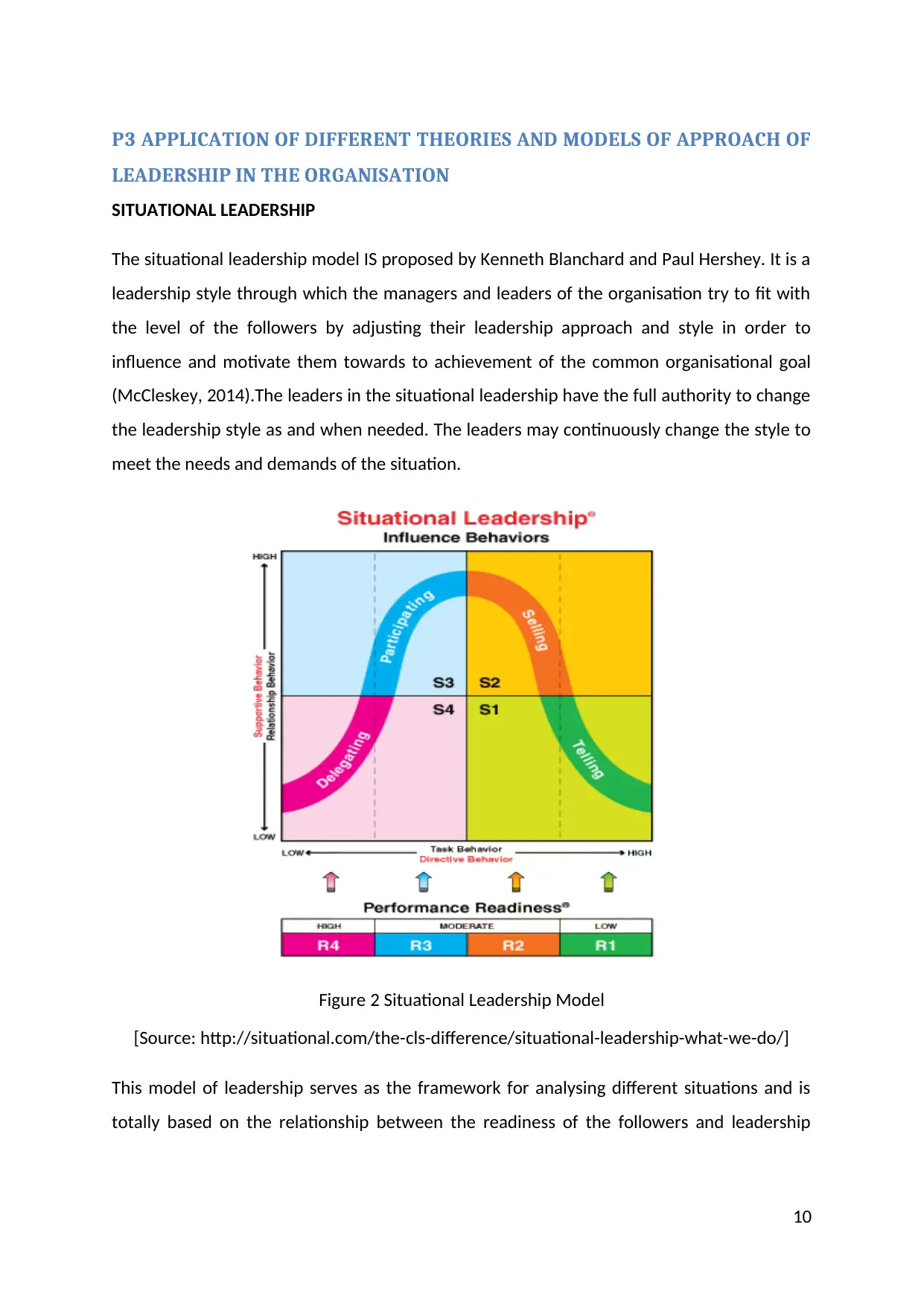
P3 APPLICATION OF DIFFERENT THEORIES AND MODELS OF APPROACH OF
LEADERSHIP IN THE ORGANISATION
SITUATIONAL LEADERSHIP
The situational leadership model IS proposed by Kenneth Blanchard and Paul Hershey. It is a
leadership style through which the managers and leaders of the organisation try to fit with
the level of the followers by adjusting their leadership approach and style in order to
influence and motivate them towards to achievement of the common organisational goal
(McCleskey, 2014).The leaders in the situational leadership have the full authority to change
the leadership style as and when needed. The leaders may continuously change the style to
meet the needs and demands of the situation.
Figure 2 Situational Leadership Model
[Source: http://situational.com/the-cls-difference/situational-leadership-what-we-do/]
This model of leadership serves as the framework for analysing different situations and is
totally based on the relationship between the readiness of the followers and leadership
10
LEADERSHIP IN THE ORGANISATION
SITUATIONAL LEADERSHIP
The situational leadership model IS proposed by Kenneth Blanchard and Paul Hershey. It is a
leadership style through which the managers and leaders of the organisation try to fit with
the level of the followers by adjusting their leadership approach and style in order to
influence and motivate them towards to achievement of the common organisational goal
(McCleskey, 2014).The leaders in the situational leadership have the full authority to change
the leadership style as and when needed. The leaders may continuously change the style to
meet the needs and demands of the situation.
Figure 2 Situational Leadership Model
[Source: http://situational.com/the-cls-difference/situational-leadership-what-we-do/]
This model of leadership serves as the framework for analysing different situations and is
totally based on the relationship between the readiness of the followers and leadership
10
Paraphrase This Document
Need a fresh take? Get an instant paraphrase of this document with our AI Paraphraser
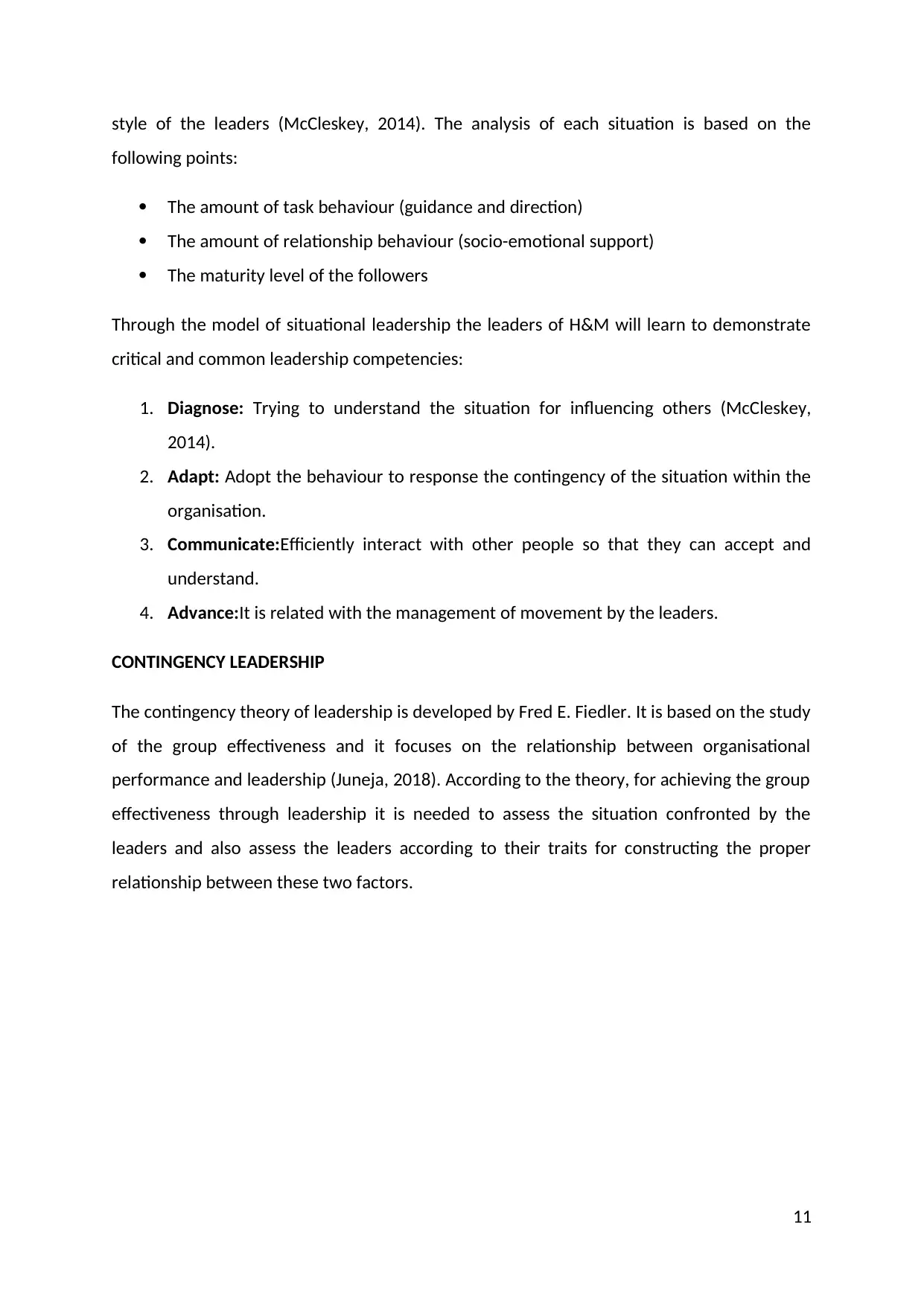
style of the leaders (McCleskey, 2014). The analysis of each situation is based on the
following points:
The amount of task behaviour (guidance and direction)
The amount of relationship behaviour (socio-emotional support)
The maturity level of the followers
Through the model of situational leadership the leaders of H&M will learn to demonstrate
critical and common leadership competencies:
1. Diagnose: Trying to understand the situation for influencing others (McCleskey,
2014).
2. Adapt: Adopt the behaviour to response the contingency of the situation within the
organisation.
3. Communicate:Efficiently interact with other people so that they can accept and
understand.
4. Advance:It is related with the management of movement by the leaders.
CONTINGENCY LEADERSHIP
The contingency theory of leadership is developed by Fred E. Fiedler. It is based on the study
of the group effectiveness and it focuses on the relationship between organisational
performance and leadership (Juneja, 2018). According to the theory, for achieving the group
effectiveness through leadership it is needed to assess the situation confronted by the
leaders and also assess the leaders according to their traits for constructing the proper
relationship between these two factors.
11
following points:
The amount of task behaviour (guidance and direction)
The amount of relationship behaviour (socio-emotional support)
The maturity level of the followers
Through the model of situational leadership the leaders of H&M will learn to demonstrate
critical and common leadership competencies:
1. Diagnose: Trying to understand the situation for influencing others (McCleskey,
2014).
2. Adapt: Adopt the behaviour to response the contingency of the situation within the
organisation.
3. Communicate:Efficiently interact with other people so that they can accept and
understand.
4. Advance:It is related with the management of movement by the leaders.
CONTINGENCY LEADERSHIP
The contingency theory of leadership is developed by Fred E. Fiedler. It is based on the study
of the group effectiveness and it focuses on the relationship between organisational
performance and leadership (Juneja, 2018). According to the theory, for achieving the group
effectiveness through leadership it is needed to assess the situation confronted by the
leaders and also assess the leaders according to their traits for constructing the proper
relationship between these two factors.
11
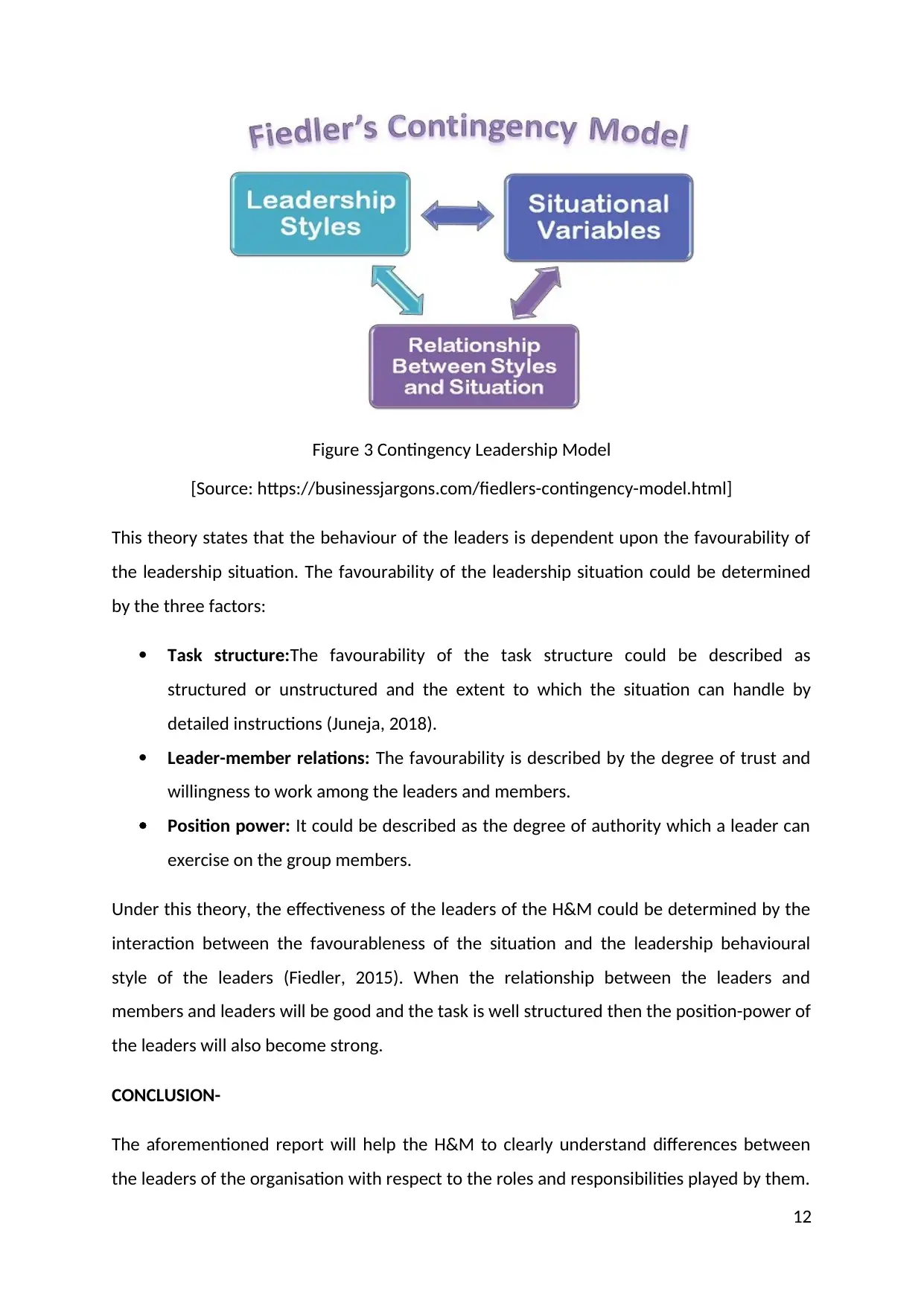
Figure 3 Contingency Leadership Model
[Source: https://businessjargons.com/fiedlers-contingency-model.html]
This theory states that the behaviour of the leaders is dependent upon the favourability of
the leadership situation. The favourability of the leadership situation could be determined
by the three factors:
Task structure:The favourability of the task structure could be described as
structured or unstructured and the extent to which the situation can handle by
detailed instructions (Juneja, 2018).
Leader-member relations: The favourability is described by the degree of trust and
willingness to work among the leaders and members.
Position power: It could be described as the degree of authority which a leader can
exercise on the group members.
Under this theory, the effectiveness of the leaders of the H&M could be determined by the
interaction between the favourableness of the situation and the leadership behavioural
style of the leaders (Fiedler, 2015). When the relationship between the leaders and
members and leaders will be good and the task is well structured then the position-power of
the leaders will also become strong.
CONCLUSION-
The aforementioned report will help the H&M to clearly understand differences between
the leaders of the organisation with respect to the roles and responsibilities played by them.
12
[Source: https://businessjargons.com/fiedlers-contingency-model.html]
This theory states that the behaviour of the leaders is dependent upon the favourability of
the leadership situation. The favourability of the leadership situation could be determined
by the three factors:
Task structure:The favourability of the task structure could be described as
structured or unstructured and the extent to which the situation can handle by
detailed instructions (Juneja, 2018).
Leader-member relations: The favourability is described by the degree of trust and
willingness to work among the leaders and members.
Position power: It could be described as the degree of authority which a leader can
exercise on the group members.
Under this theory, the effectiveness of the leaders of the H&M could be determined by the
interaction between the favourableness of the situation and the leadership behavioural
style of the leaders (Fiedler, 2015). When the relationship between the leaders and
members and leaders will be good and the task is well structured then the position-power of
the leaders will also become strong.
CONCLUSION-
The aforementioned report will help the H&M to clearly understand differences between
the leaders of the organisation with respect to the roles and responsibilities played by them.
12
⊘ This is a preview!⊘
Do you want full access?
Subscribe today to unlock all pages.

Trusted by 1+ million students worldwide
1 out of 22
Related Documents
Your All-in-One AI-Powered Toolkit for Academic Success.
+13062052269
info@desklib.com
Available 24*7 on WhatsApp / Email
![[object Object]](/_next/static/media/star-bottom.7253800d.svg)
Unlock your academic potential
Copyright © 2020–2025 A2Z Services. All Rights Reserved. Developed and managed by ZUCOL.




